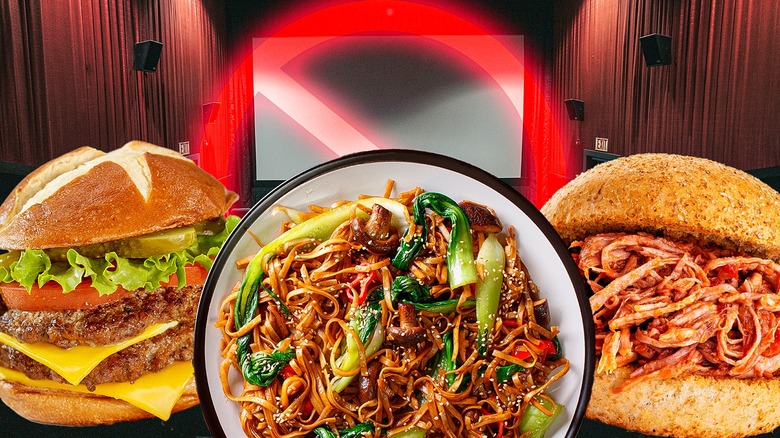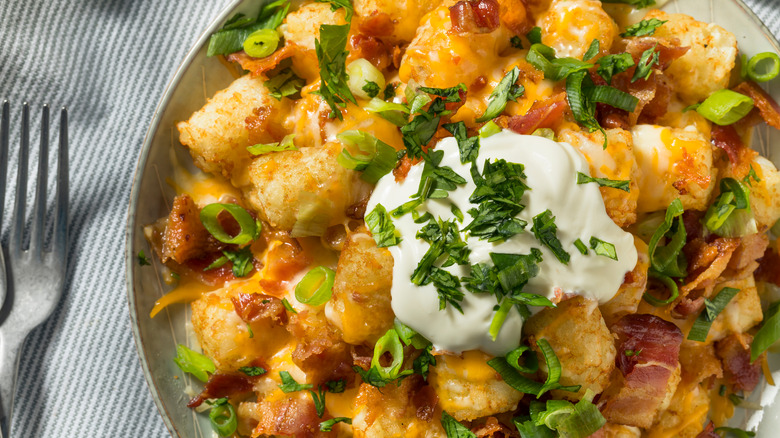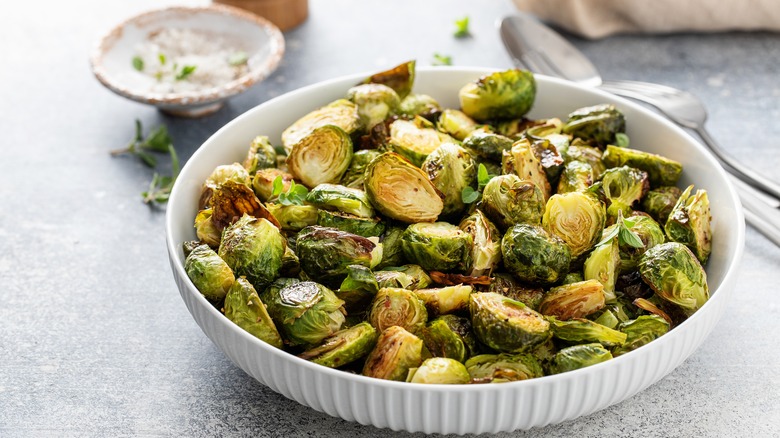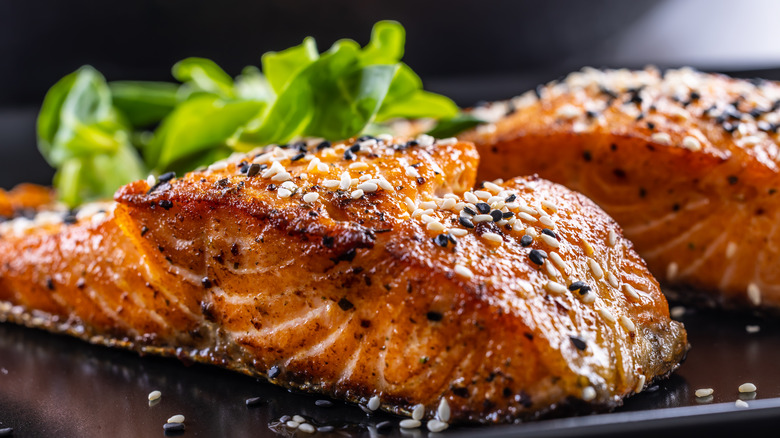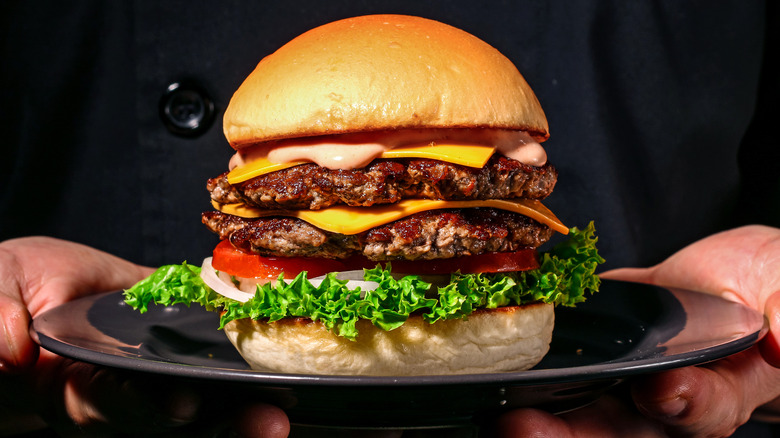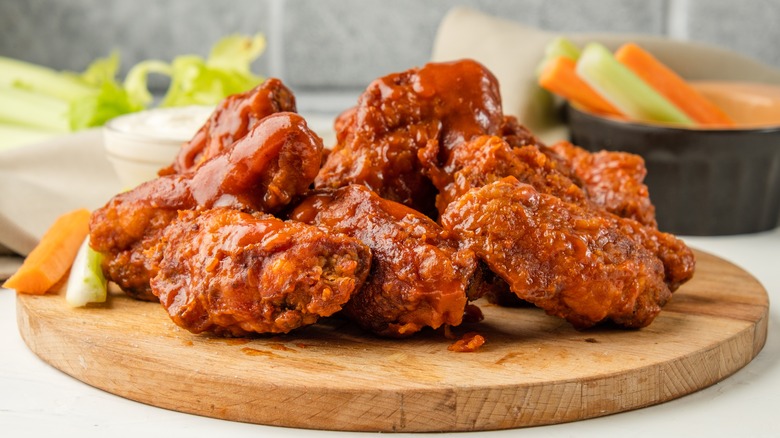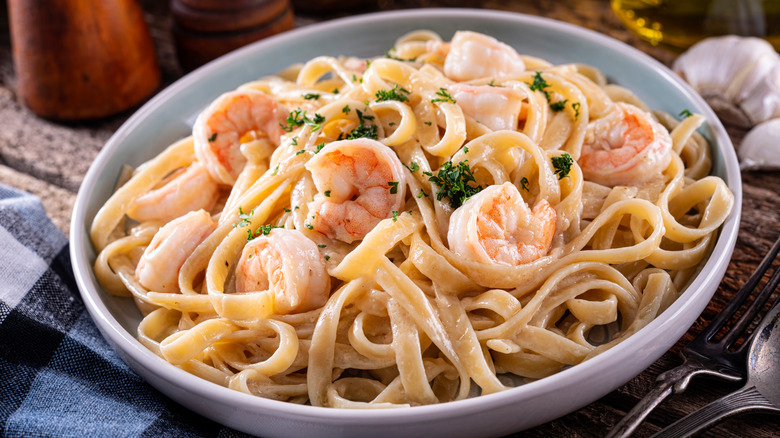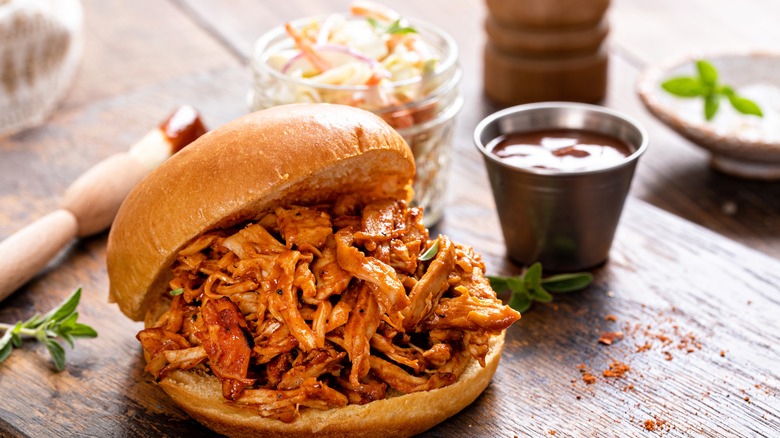7 Dishes You Should Never Order At A Dine-In Movie Theater
Dinner and a movie. This classic concept, which once meant dinner and then a movie, has more recently evolved into a one-stop theatrical experience — and the convenience factor couldn't be higher. Movie theaters across the country now have full menus and full bars, and while most of their food options are well suited to dining in the dark, that's not necessarily the case for every offering.
That's because there are more factors to consider when you're eating in a movie theater than there are when you're eating in a restaurant. First, and perhaps most obvious, is the fact that the theater will be dark, making it more difficult to see and eat your food. But it goes beyond that. What kind of tables does the theater have? Does the table swivel up to your chair, or is it in a fixed position that you have to lean over to eat? And what about the smell? Will it be bothersome to your seatmates? Will it linger if your plate isn't cleared as soon as you're finished eating and bother you too?
When you start to think about it in those terms, choosing a meal for a matinee or a snack for a midnight showing might suddenly seem complicated. But by reviewing the menu online beforehand and following these suggestions of foods to steer clear of, your next dine-in movie experience is sure to be a five-star event.
Anything described as loaded
Many dine-in movie theaters have some sort of loaded snack on their menu. Whether the base is French fries, tater tots, or even a hot dog, loaded dishes are usually piled high with bacon, melted cheese, sour cream, and often more. An even greater challenge to eat in the dark, perhaps, are loaded nachos, as they typically come with even more toppings, like black beans, corn, jalapeños, onion, and pico de gallo, just to name a few.
Enticing as all those toppings are, attempting to eat loaded fries, hot dogs, nachos, or tots in a dark theater is a balancing act at best. Unless you're holding your plate up to your chest and eating with a fork, you run the risk of those tempting toppings sliding right off of their precarious perch and landing directly in your lap. Not only that, but you're bound to end up with sauce all over your fingers, and if you don't have a stack of extra napkins at the ready, you could be stuck waiting for a server to bring you more. To avoid having a big mess on your hands or in your lap, it's probably best to save the loaded options for dining rooms with better lighting.
Brussels sprouts
If you're looking for a healthy movie snack, fried Brussels sprouts probably aren't your best bet. Delicious as they are, crispy Brussels sprouts have a distinct smell that isn't exactly ideal for a crowded movie theater. The science behind the smell of Brussels sprouts is simple: When cooked, Brussels sprouts give off a gas called hydrogen sulfide, which, unfortunately, has an odor similar to that of rotten eggs. Reducing cooking time to less than five minutes can prevent hydrogen sulfide from being released, but since you can't get a behind-the-scenes look at the theater's recipe, you're better off opting for a salad or a grain bowl as a healthy alternative to Brussels sprouts.
That said, some theaters have dishes that feature Brussels sprouts as a supporting character instead of the main attraction. Alamo Drafthouse, for example, has Brussels sprouts, bacon, and goat cheese pizza, and its fried chicken sandwich is served with Brussels sprouts, kale, and carrot slaw. Dishes like these are perfect for those times when you're craving the distinct crunch of a Brussels sprout but you don't want to risk getting any sideways glances from your fellow moviegoers.
Cooked seafood
Eating blackened, grilled, or roasted seafood in a movie theater is kind of like reheating fish in an office microwave: You might enjoy it, but chances are, those around you won't. Anyone who's cooked seafood at home or even ordered seafood at a restaurant knows how that potent, fishy smell can often linger long after you've finished eating. And when you're dining in a dark, confined space while watching a movie that could run up to two or three hours, the last thing you or your seatmates want is the scent of cooked fish or shrimp lingering in the air.
Thankfully, there's usually an odor-free alternative in fried seafood. Fish and chips, for example, are on the menu at dine-in movie theaters like Cinépolis and IPIC theaters, and CMX CinéBistro and LOOK Cinemas both serve fried shrimp. So next time you're tempted to order fish or shrimp at a theater, check to see if there's a fried version that you and your neighbors can all agree on.
Double burgers
Double burgers in a dark theater are double the trouble. They're a handful any time, but trying to plan your next bite in the dark? That sounds like an impossible task. Approach a double burger from the slightest wrong angle, and chances are good that one or both patties — and possibly some of the toppings, too — will slide right out the back of the bun. What's worse is that if you're not careful, all those fixings could wind up in your lap, not only causing a huge mess but distracting you from the movie.
Luckily, single burgers are a fixture on just about every dine-in movie theater menu. Better yet, some theaters, including Cinépolis and IPIC, have sliders on their menus, which are even easier to navigate in the dark than a single burger. When in doubt, stick with a single or a slider and save the double burgers for another time and place altogether.
Extra spicy dishes
It's safe to say that a dark, possibly crowded movie theater is simply not the right place to experiment with your spice tolerance. Unless you know for certain that you can take the heat, it's best to avoid those menu items that are marked with a pepper icon (or two). For one, foods that are too spicy can quickly and easily cause you to cough, which is not only uncomfortable for you but disturbing to your fellow cinephiles.
What's more, servers in dine-in theaters aren't always as readily available as servers in traditional restaurants. If you don't have enough water (or milk, depending on just how hot your dish is) to cleanse your palate, you might find yourself having to get up from your seat to get a refill, causing you to miss part of the movie. In that case, you're better off saving the spice for a cozy night at home, where you can cough freely and pause a movie any time you like.
Noodles
Let's be honest: Generally speaking, noodles are not the easiest nor the most elegant thing to eat. First, there's the delicate dance of using a spoon to twirl the noodles onto your fork. Then there's the balancing act of making sure your noodles stay tightly wrapped around the fork so all your hard work doesn't go to waste. And finally, there's the task of eating the whole bite in one go without splashing sauce on your face or having to slurp up that final strand of pasta. Needless to say, trying to manage all of that for one just bite of noodles in the dark — let alone an entire bowl of pasta — sounds like a tall order at best.
Fortunately for those with a hankering for pasta, mac and cheese, and even ravioli can be found on many movie theater menus and are a much more manageable alternative to noodles. They can easily be eaten with a fork, and you won't run the risk of annoying your neighbors with any spaghetti slurping sounds — a win-win in our book.
Sandwiches that aren't spill-proof
Overall, sandwiches are a safe bet when you're eating in a movie theater. For starters, they're portable and typically don't require much or any cutting and eating with a knife and fork. That is, unless you've ordered something inherently messy, like a pulled pork sandwich. All it takes is one bite for those delicious fillings to fall right out of the bun, leaving you with a big mess on your hands — literally.
There are two especially tricky elements to barbecue sandwiches like these: The fact that the meat is chopped or pulled and the fact that it's coated in sauce. When you order a burger, for example, there's usually one patty and the condiments are usually spread only on the inside of the bun. That makes it easy to keep the burger together and avoid too much spillage. With a pulled pork sandwich, on the other hand, nothing is keeping the meat together, and the sauce makes it more likely to slide out — and that's just a recipe for disaster.
